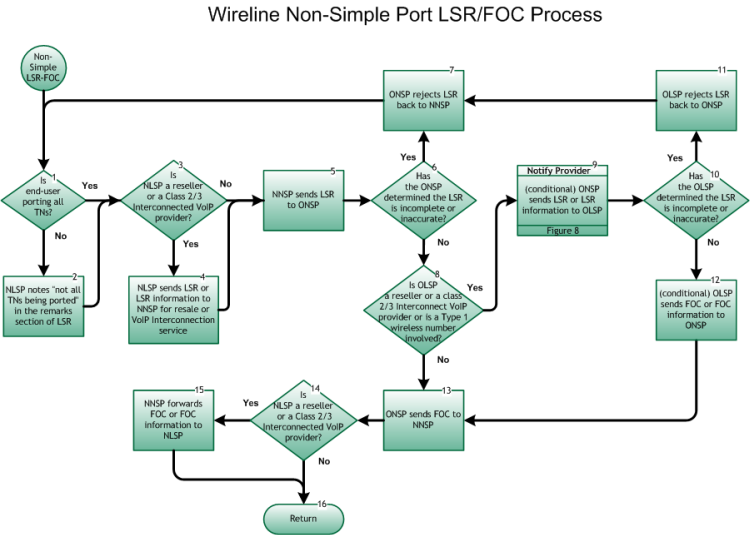Step 1: Is End User porting all TNs?
- The NLSP determines if customer is porting all TN(s).
- If Yes, go to Step 3.
- If No, go to Step 2.
Step 2: NLSP notes “Not all TNs are being ported” in the remarks section of LSR
- The NLSP makes a note in the remarks section of the LSR to identify that the End User is not porting all TN(s). This can affect the due date interval due to account rearrangements necessary prior to service order issuance.
Step 3: Is NLSP a Reseller or Class 2 or 3 Interconnected VoIP Provider?
- If Yes, go to Step 4.
- If No, go to Step 5.
Step 4: NLSP sends LSR or LSR information to NNSP for resale or VoIP Interconnection service
- NLSP (Reseller or Class 2 or 3 Interconnected VoIP Provider) sends an LSR or LSR Information to the NNSP fulfilling all requirements of any service agreement between the involved service providers. The LSR process is defined by the Ordering and Billing Forum (OBF) and the electronic interface by the Telecommunications Industry Forum (TCIF).
Step 5: NNSP sends LSR to ONSP
- The NNSP notifies the ONSP of the port using the LSR and sends the information via an electronic gateway, FAX, email, or manual means. The LSR process is defined by the Ordering and Billing Forum (OBF) and the electronic interface by the Telecommunications Industry Forum (TCIF).
Step 6: Has the ONSP determined the LSR is incomplete or inaccurate?
- If Yes, go to Step 7.
- If No, go to Step 8.
Step 7: ONSP rejects LSR back to NNSP
- ONSP sends a Reject Notification to the NNSP due to insufficient or inaccurate data on the LSR.
- Return to Figure 5, Step 1.
Step 8: Is OLSP a Reseller or Class 2 or 3 Interconnected VoIP Provider or is a Type 1 wireless number involved?
- If Yes, go to Step 9.
- If No, go to Step 13.
Step 9: Notify Provider – (conditional) ONSP sends LSR, LSR information, to OLSP
- ONSP sends an LSR, LSR Information to the OLSP (Reseller or Class 2 or 3 Interconnected VoIP Provider or if a Type 1 number is involved) fulfilling all requirements. The LSR process is defined by the Ordering and Billing Forum (OBF) and the electronic interface by the Telecommunications Industry Forum (TCIF). (conditional, based on any service agreement between the involved service providers)
- Communication between the ONSP and the OLSP with regard to the port must not delay the validation or processing of the port request.
- Inter-Service Provider LNP Operations Flows – Reseller/Interconnected VoIP Provider/Type 1 Notification – Figure 8
.
Step 10: Has the OLSP determined the LSR is incomplete or inaccurate?
- If Yes, go to Step 11.
- If No, go to Step 12.
Step 11: OLSP rejects LSR back to ONSP
- OLSP sends a Reject Notification to the ONSP due to insufficient or inaccurate data on the LSR.
- Return to Figure 5, Step 1.
Step 12: OLSP sends FOC or FOC information to ONSP (conditional)
- The OLSP notifies the ONSP of the porting using the FOC and sends the information via an electronic gateway, FAX, email, or other means. The LSR/FOC process is defined by the Ordering and Billing Forum (OBF) and the electronic interface by the Telecommunications Industry Forum (TCIF). The information required on the FOC may vary based on the carriers involved. (conditional, based on any service agreement between the involved service providers)
- Communication between the ONSP and the OLSP with regard to the port must not delay the validation or processing of the port request.
Step 13: ONSP sends FOC to NNSP
- ONSP sends the Firm Order Confirmation (FOC, local response) to the NNSP for the porting LSR.
- For wireline to wireline service providers, and between wireline and wireless service providers, the requirement is that the FOC is returned within 24 clock hours, excluding weekends and Old Service Provider-defined holidays. It is the responsibility of the ONSP to contact the NNSP if the ONSP is unable to meet the 24 clock hour requirement (excluding weekends and Old Service Provider-defined holidays) for transmitting the FOC. If the FOC is not received by the NNSP within 24 clock hours (excluding weekends and Old Service Provider-defined holidays), then the NNSP may contact the ONSP.
- It is assumed that the porting interval is not in addition to intervals for other requested services (e.g., unbundled loops) related to the porting request. The interval becomes the longest single interval required for the services requested.
- The LSR/FOC process is defined by the Ordering and Billing Forum (OBF) and the electronic interface by the Telecommunications Industry Forum (TCIF). The information required on the FOC may vary based on the carriers involved.
Step 14: Is NLSP a Reseller or Class 2 or 3 Interconnected VoIP Provider?
- If Yes, go to Step 15.
- If No, go to Step 16.
Step 15: NNSP forwards FOC or FOC information to NLSP
- NNSP forwards FOC or FOC Information to NLSP fulfilling all requirements of any service agreement between the involved service providers. The LSR/FOC process is defined by the Ordering and Billing Forum (OBF) and the electronic interface by the Telecommunications Industry Forum (TCIF). The information required on the FOC may vary based on the carriers involved.
Step 16: Return to Figure 1

